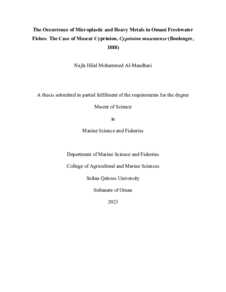Document
The Occurrence of microplastic and Heavy Metals in Omani Freshwater Fishes: The Case of Muscat Cyprinion, Cyprinion muscatense (Boulenger, 1888).
Source
Master's thesis
Country
Oman
City
Muscat
Publisher
Sultan Qaboos University
Gregorian
2023
Language
English
Thesis Type
Master's thesis
English abstract
Heavy metals and microplastics are among the most harmful forms of environmental contamination due to their toxicity and persistent nature, which have caused these toxic substances to grow and increase, causing major concerns for local consumers. This research focuses on the study of microplastics and heavy metals in three locations in Oman: Muscat/Al-Amrat, Muscat/Al Khoudh, and Samail/Suroor, and targets Cyprinion muscatense fish, which is considered a native freshwater fish found in several areas in Oman. The study collected fish samples and conducted analyses for heavy metals and microplastics. The Metal Pollution Index (MPI) assessed overall metal pollution levels, and health risk assessments for fish consumption were conducted, including Estimated Daily Intake (EDI), Target Hazard Quotients (THQ), and Carcinogenic risk assessments. The analysis of microplastic particle counts per gram in three sites shows that Al Khoudh has a higher number of microplastics (7 items/g) compared to Al-Amrat and Suroor (3.9 and 4 items/g, respectively). Microplastic levels were higher in the trunk of fish (5.5 particles/g) than in other parts (tail: 5 particles/g, head: 4 particles/g). In general, black microplastics are dominant in all three sites, with (11 particles/g). Fiber microplastics were the most prevalent type across three locations, with an average abundance of (3.3 particles/g), surpassing film (1.5 particles/g) and fragment (0.3 particles/g) microplastics. Moreover, the study examined heavy metals (Cd, Cr, Cu, Ni, Pb, Zn, Hg) in the fish in the three sites. Al-Khoudh exhibits the highest metal concentrations for most metals, including Pb (68.796 mg/kg). The comparison of mean metal concentrations among Al-Khoudh, Al-Amrat, and Suroor showed no significant difference for most metals (p > 0.05), except for Ni, Pb, and Hg. Unexpectedly, Suroor exhibited the highest mercury concentration (0.013 mg/kg). Spatially, heavy metals accumulated more in the tail region of the fish samples. Heavy metals like Cd and Pb, which can cause health issues, were assessed for Estimated Daily Intake (EDI) by Omanis based on mean metal concentrations in fish and consumption rates. Al-Khoudh had the highest EDI for Pb and Zn (0.2970 and 0.4318 mg/kg/day), while Al-Amrat and Suroor had lower EDI values, reflecting differences in metal pollution levels and dietary habits. The Target Hazard Quotient (THQ) assessment for heavy metals in fish indicates potential health risks for consumers. In Al-Khoudh, metals like Cu, Ni, and Pb had THQ values exceeding 1, with Pb reaching a high THQ of 82.5092. Similarly, Al-Amrat and Suroor exhibited THQ values exceeding 1 for Cu and Pb, indicating potential toxicity and health risks VII associated with daily consumption of these metals. Furthermore, the study explored the relationship between microplastics and heavy metal elements in fish species across locations. While a positive linear relationship was found between MPs and metal content in Suroor and Al Amrat, Al-Khoudh exhibited a different pattern, indicating additional influencing factors. Overall, this study contributes valuable information to the understanding of microplastic pollution and heavy metal contamination in aquatic ecosystems. The findings underscore the importance of continuous research and monitoring to develop comprehensive strategies for mitigating environmental hazards and protecting the health of aquatic organisms and human populations.
Category
Theses and Dissertations

